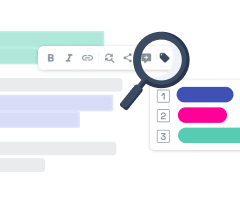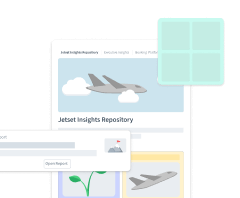
How Companies Invite Their UX Research Participant Panels
Recruiting participants can be challenging, especially in qualitative research. We are looking for participants that match a set of specific, often very particular criteria. And here, participant panels come in. In theory, a participant panel allows you to recruit participants from a pool of pre-screened potential participants. You can use third-party panels, but some companies choose to build their own panel.
This internal approach frequently piques some interest in research communities. While introducing internal panels requires a participant database and thinking about how people inside your company will find participants for upcoming studies, especially how to invite people to the panel seems to be of particular interest.
So this is what we are doing here: Find examples of how companies invite people to join their internal panels for upcoming research studies in this article.
Participant panels: the do it yourself approach
Participant panels describe a pool of potential participants who have agreed to participate in ongoing research efforts. The panel includes meta-information about demographics, interests or technology usage, or any other information relevant to your research interests. It also provides contact details to reach out to them quickly. The panel often reflects a group of loyal customers who have opted-in for research study participation.
Participants in the panel are recruited with the intent to participate in various research activities over the long term.
Pros & Cons of internal participant panels
As internal participant panels describe a very particular type of recruiting, we want to put it into perspective with a quick overview of the advantages and disadvantages, before looking at some examples.
The Pros
Recruiting for upcoming studies will become easier as your panel is your starting point, and you may find participants with just a few clicks.
It can enable you to do qualitative research more frequently and quicker, as you can access research-fitting participants directly.
This approach will save you time in upcoming studies, as some administrative tasks are already done, and manual recruiting will no longer be necessary in every case.
The Cons
A panel won’t work for everyone and is probably more suitable for companies with a large, existing user base. To recruit participants that fit your study well, you need to have already many people being part of the panel.
You need a long breath: Building and maintaining your panel will pop a lot of operational questions, like: How to avoid contacting participants too often? How to compensate participants for taking part in studies? What information do we need to screen upfront? How can colleagues recruit from the internal panel?
Your research studies will be biased towards people who have already actively shown interest in participating and tend to be heavy users. When looking for participant profiles who usually don’t have much time, it will remain a challenge to recruit them, even with an internal panel.
Be aware of the risk that your internal panel may attract professional study participants who join solely for the promised incentives.
Recruiting Participants for your own Panel - Example Pages:
Below you find some examples of how companies invite people to become part of their participant panels on their website:
Atlassian
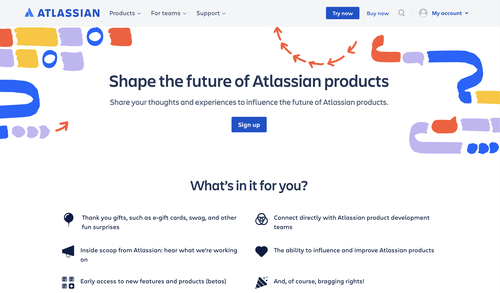
💬 How they call their panel: Research Group
👋 How they invite people to join: “Shape the future of Atlassian products: Share your thoughts and experiences to influence the future of Atlassian products.”
⭐️ Special characteristics: Incentives highlighted prominently, unique design elements and colors for Research Group Panel, preview on how participation might look like, FAQ
Dropbox

💬 How they call their panel: Research at Dropbox
👋 How they invite people to join: “Help shape the future of Dropbox: We built Dropbox to help people work better together. That’s why we’re looking for people like you to tell us if we’re on the right track. Good or bad, we want to hear it all. Your feedback helps us improve Dropbox to better meet your needs.”
⭐️ Special characteristics: On-site and remote participation highlighted, online consent form highlighted, simple design, FAQ
Sketch
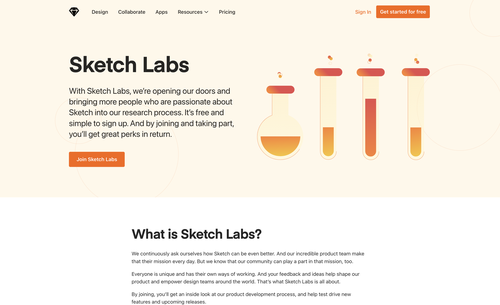
💬 How they call their panel: Sketch Labs
👋 How they invite people to join: "With Sketch Labs, we're opening our doors and bringing more people who are passionate about Sketch into our research process. It's free and simple to sign up. And by joining and taking part, you'll get great perks in return."
⭐️ Special characteristics: Branded as a research lab, clear layout following leading questions from users, list of potential study methods and descriptions
Microsoft

💬 How they call their panel: User Research at Microsoft
👋 How they invite people to join: “Our products, your way: We want you to influence the next wave of Microsoft products. Your involvement will make products easier to use and help shape future technology. Where else can you impact the lives of so many users around the world?”
⭐️ Special characteristics: Emphasis on participant impact on future technology, minimalistic content focused on who can participate and what participants will do in a moderated study

💬 How they call their panel: User Experience Research at Google
👋 How they invite people to join: “Help shape the future of Google: Your feedback is important to us. We’d love to know your thoughts, so we can keep making Google products that fit your needs. You’ll get to influence things millions of people use every day, from email and productivity apps to tools for developers and educators. Even if you don’t currently use Google products, you can still sign up for a chance to participate in our research. If one of our studies is a good fit for you, we’ll get in touch with details and next steps. Most participants will get a small thank-you gift.”
⭐️ Special characteristics: Prominent invitation focused on the value of feedback from Google users and also non-users, banner with current information on how COVID-19 restrictions may impact UX Research participation, illustrated preview on how participation may look like
Adobe

💬 How they call their panel: Adobe User Research Program
👋 How they invite people to join: “Adobe wants to hear from you: Thanks for your interest in user research at Adobe. By participating in our program and giving us feedback, you can help us build products, services, and experiences that fit your needs — and you can influence the products you use and (possibly) get a sneak peek at future products. You’ll be provided an incentive as a thank you for your valuable time in all research studies you participate in.”
⭐️ Special characteristics: Emphasis on the potential impact on products people already use and on future products and services that will fit one's needs, list of active research initiatives, information on how researchers will reach out, and study setting
Salesforce

💬 How they call their panel: Salesforce Research Program
👋 How they invite people to join: “Help transform the future of Salesforce and our products. Input from our customers is crucial to how we innovate our products. During a research study, we’ll gather your thoughts to help guide us to build better experiences and develop products that best serve our customers' needs.”
⭐️ Special characteristics: Emphasis on customer feedback, remote and onsite participation and how to participate, link to an extensive Instructions & FAQ page
IBM

💬 How they call their panel: Cloud User Research at IBM
👋 How they invite people to join: “Let's shape the future of IBM products together: We want to hear about your user experiences — what’s working and what’s not working. Join our user research studies and tell us what you think.”
⭐️ Special characteristics: Reasons to sign up prominently featured, exclusive access to future IBM Cloud Solutions placed as main incentive, Co-creation with researchers highlighted, FAQ
Workday
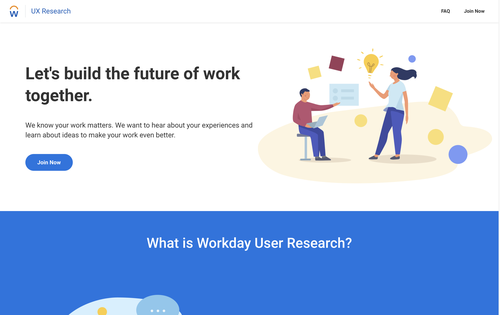
💬 How they call their panel: Workday User Research
👋 How they invite people to join: “Let's build the future of work together. We know your work matters. We want to hear about your experiences and learn about ideas to make your work even better.”
⭐️ Special characteristics: A highlighted section that explains what user research at Workday is, reasons to sign up featured including exclusivity of research invites, a preview of next steps
coinbase
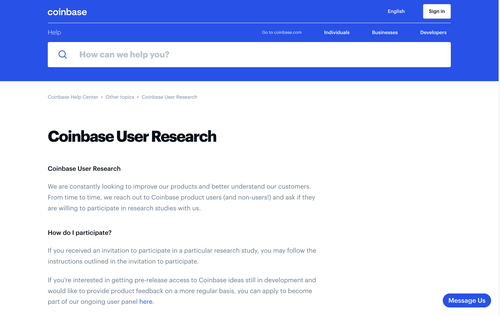
💬 How they call their panel: Coinbase User Research
👋 How they invite people to join: “We are constantly looking to improve our products and better understand our customers. From time to time, we reach out to Coinbase product users (and non-users!) and ask if they are willing to participate in research studies with us.”
⭐️ Special characteristics: Placed within the help center, emphasis on how users recognize if a research request is legitimate, a section on option for anonymous participation and storage of personal information, emphasis on the invitation of users and non-users
intuit
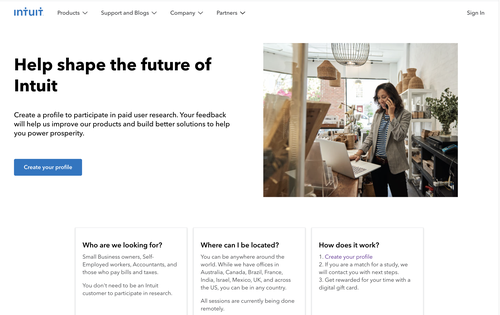
💬 How they call their panel: User Research at intuit
👋 How they invite people to join: “Help shape the future of Intuit: Create a profile to participate in paid user research. Your feedback will help us improve our products and build better solutions to help you power prosperity.”
⭐️ Special characteristics: Clear description of who they are looking for, emphasis on an invitation for customers and non-customers, current information on remote participation, sign up CTA "Create your profile"
As we know that this is frequently of interest in different research communities, we are curious: Do you want to learn more about companys’ own user research participant panels and how they help companies in their research practice? Let us know and send us your questions on that topic.
Want to read more? Check out our articles about creating an engaging user research presentation and making UX research accessible.

